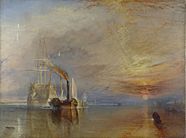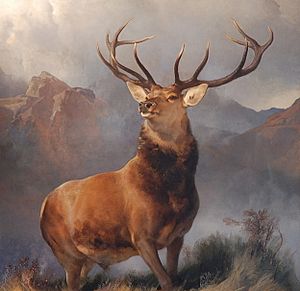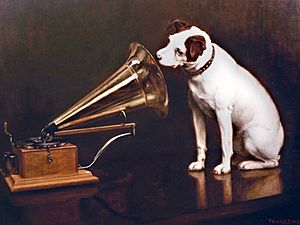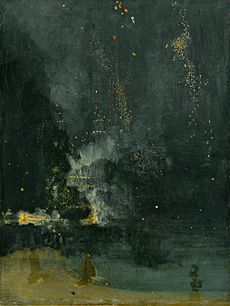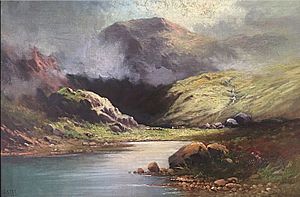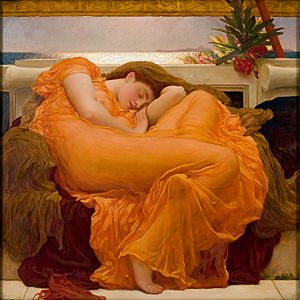Victorian painting facts for kids
Victorian painting describes the art styles popular in the United Kingdom when Queen Victoria was in charge (from 1837 to 1901). When Victoria first became Queen, Britain was changing fast. New factories and inventions made it one of the most powerful countries.
At first, painting was mostly controlled by the Royal Academy of Arts. They followed ideas from an old Italian painter named Raphael. Artists believed their job was to make everything look perfect and noble. This worked well when they mostly painted rich people or historical battles. But as Britain became more industrial, people wanted art that showed real life, not just ideal scenes. A new group of wealthy middle-class people also started buying art. They wanted paintings that were accurate and detailed.
In the late 1840s, a group of young art students started the Pre-Raphaelite Brotherhood. They wanted to paint things exactly as they saw them in nature. If they painted imaginary scenes, they tried to make them look as real as possible. They also thought art should teach moral lessons. These artists were very interested in new scientific discoveries. Even though the Pre-Raphaelite Brotherhood didn't last long, their ideas had a big impact.
After the Franco-Prussian War in 1870, many French artists came to London. They brought new styles like Impressionism. At the same time, life in British cities became harder due to economic problems and more machines. Artists started to move away from showing reality. A new group called the aesthetic movement believed art should focus on beauty and noble actions. They felt that focusing on the "ugly" reality made art worse. Many artists began painting scenes from the past, before factories and cities. Some also painted religious art, even if they weren't religious, because it let them create beautiful, ideal scenes.
The Victorian era ended in 1901. For a long time after that, Victorian art was not popular. Modern artists in the 20th century looked to European art for inspiration, not British art from the 1800s. Victorian painters had often disliked these European styles. So, modern artists and critics often made fun of or ignored Victorian art. But in the 1960s, some Pre-Raphaelite art became popular again. People saw connections between their work and new art trends. Several art shows in the 1960s and 1970s helped bring them back into favor. A big Pre-Raphaelite art show in 1984 was very successful. While Pre-Raphaelite art is now well-known, other Victorian paintings are still not as popular.
Contents
How Victorian Art Began

When Queen Victoria became queen in 1837 at age 18, Britain had been peaceful for many years. New laws had made the government more stable. The Industrial Revolution was in full swing. Railways were connecting cities, making Britain a powerful industrial nation. The Great Exhibition in 1851 celebrated Britain's technology and inventions. Victoria's husband, Prince Albert, helped organize it. Millions of people visited to see the latest manufacturing and engineering.
Before this, rich landowners controlled Britain's economy. But the Industrial Revolution created a new, wealthy middle class. These people were merchants, factory owners, and engineers. They loved to show off their wealth by buying art. They often preferred new paintings by British artists over older European works. In 1844, "art unions" became legal. These groups bought art from famous artists and then gave it away as prizes in lotteries. This made art more accessible to more people. It also helped create a market for printed copies of artworks.
Old Ideas: Reynolds and the Royal Academy
British painting was greatly shaped by Joshua Reynolds (1723–1792). He was the first head of the Royal Academy of Arts. Reynolds believed that art should show subjects in a "poetical manner." He thought artists should try to make their subjects look as perfect as possible, like the Italian painter Raphael.
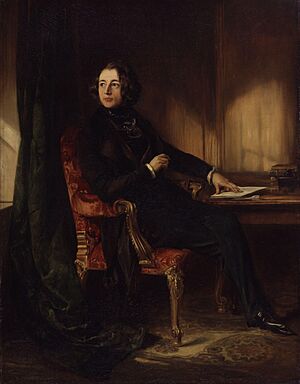
By the time Victoria became queen, the Royal Academy was very powerful. Their yearly art show was the most important art event. The Academy's art schools taught a very specific way of painting. This style worked well for painting rich families or historical scenes. But many felt it was becoming old-fashioned. After the Houses of Parliament burned down in 1834, there was a competition to find artists to decorate the new building. This showed that Britain didn't have many artists who could paint big historical scenes well. A popular magazine called Punch often made fun of the Royal Academy.
John Ruskin's important book, Modern Painters, came out in 1843. He argued that art should show the world exactly as it is. He believed artists could only show the beauty of nature by painting it accurately. Young artists, who grew up with new technologies, agreed with this idea. They valued accurate details. Also, in 1837, Charles Dickens started writing novels that showed the real problems of modern life. Many rising artists admired his work.
In 1837, painter Richard Dadd and his friends formed a group called The Clique. They rejected the Academy's focus on history and portraits. Instead, they painted everyday scenes. Most of The Clique artists later returned to the Royal Academy. But they were one of the first groups to challenge the Academy's power.
J. M. W. Turner: A Master of Light
When Victoria became queen, J. M. W. Turner was the most famous British artist. He became known for his landscape watercolors and oil paintings. He was a strong supporter of the Royal Academy. John Ruskin's first book, Modern Painters, defended Turner's work. Ruskin said Turner's greatness came from showing nature accurately, not from trying to make things look ideal.
By the 1840s, Turner's style was starting to go out of fashion. Younger artists thought his work was too dramatic and old-fashioned. They felt he belonged to an earlier, more Romantic period that didn't fit the modern age.
The Pre-Raphaelite Brotherhood: Art with a Message
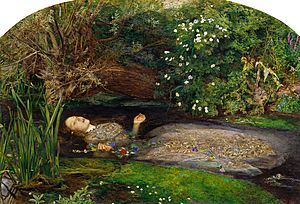
In 1848, three young art students, William Holman Hunt, John Everett Millais, and Dante Gabriel Rossetti, formed the Pre-Raphaelite Brotherhood (PRB). They disagreed with Joshua Reynolds's ideas. Their main rule was to paint from nature as accurately as possible. If they had to imagine a scene, they tried to show it exactly as it would have happened, not just to make it look pretty.
The PRB was inspired by scientific shows. They believed their scientific approach to art was good for morals. The intense detail in their paintings showed hard work and dedication. This was different from the "lazy" techniques of older artists. They also felt artists should choose subjects that taught moral lessons. Early PRB paintings often included flowers. Flowers could be used in many scenes and could carry hidden meanings, like in the popular "language of flowers." Painting them accurately also showed the artist's dedication to scientific detail.
The Victorian age saw many scientific discoveries. New findings in geology and astronomy challenged old religious ideas. The PRB found these advances fascinating. They liked the focus on detail and the willingness to question old beliefs based on facts. William Holman Hunt, a PRB founder, changed religious art in England. He visited the Holy Land and studied old evidence to paint biblical scenes as accurately as he could.
By 1854, the PRB group itself had broken up. But their style continued to be very important in British painting. Their works were well-received at the 1855 Paris World's Fair. The Art Treasures Exhibition in Manchester in 1857 attracted many visitors. This helped spread awareness of modern painting styles. In 1856, art collector John Sheepshanks gave his collection of modern paintings to the nation. These paintings, along with others from the Great Exhibition, formed the South Kensington Museum (now the Victoria and Albert Museum and Science Museum).
At this time, painting was mostly done by men. In 1859, 38 female artists asked the Royal Academy to let women join. The next year, Laura Herford was accepted as the first female student. The Slade School of Fine Art, started in 1871, actively welcomed female students.
Animal Painting: Showing Nature's Spirit
Britain has a long history of animal painting, going back to George Stubbs (1724–1806). This type of art gained respect thanks to James Ward in the early 1800s. Breeding animals, especially dogs, became very popular. This created a demand for paintings of prize-winning animals. The Scottish Highlands also became a popular place for wealthy Britons to visit, especially for hunting.
One artist, Edwin Landseer (1802–1873), took advantage of this trend. He visited Scotland every year to hunt, fish, and sketch.
Landseer became famous for his paintings of Scotland's landscapes, people, and wildlife. His art, along with Sir Walter Scott's novels, helped shape how people in Britain imagined Scotland. His paintings were so popular that the rights to make prints of them often sold for much more than the original painting. He also designed the bronze lions at the base of Nelson's Column, which were unveiled in 1867.
Landseer and other animal painters like Briton Rivière were also known for their emotional paintings of dogs. Landseer's The Old Shepherd's Chief Mourner, showing a sheepdog next to a coffin, was highly praised. Many artists of this time were hunters. They believed nature could be cruel. Dogs showing emotions became a popular subject. This suggested a noble side to nature, especially as religious faith was changing.
The Aesthetic Movement: Art for Beauty's Sake
In the 1870s, a long economic downturn hit Britain. The hopeful spirit of progress, once seen in the Great Exhibition, began to fade. Some artists felt that modern life was becoming "soulless" because of machines and the focus on money. The Franco-Prussian War in 1870 caused many French artists, like Claude Monet, to move to London. They brought new painting styles with them. Art critic Walter Pater's book The Renaissance (1873) argued that life should be about enjoying beauty and art for their own sake.
Because of this, a new group of painters emerged. Artists like Frederic Leighton and James Abbott McNeill Whistler moved away from telling stories or teaching morals in their art. They painted works simply for their beauty. Whistler criticized the Pre-Raphaelites' focus on realism. He felt people were looking "through" a picture, not "at" it. The Pre-Raphaelites and the Royal Academy strongly disliked this new style. This led to Sir Coutts Lindsay opening the Grosvenor Gallery in 1877 to show art that the Royal Academy ignored.
Things got heated in 1877 when John Ruskin saw Whistler's Nocturne paintings. He wrote that Whistler was "asking two hundred guineas for flinging a pot of paint in the public's face." Whistler sued Ruskin for libel. The case went to court in 1878. The judge famously asked Whistler, "Which part of the picture is the bridge?" when looking at Nocturne: Blue and Gold – Old Battersea Bridge. Whistler won, but only received a tiny amount of money, and the trial costs made him go bankrupt.
The aesthetic movement became more and more popular. It was supported by Whistler and Oscar Wilde. The popular comic opera Patience also helped make it well-known. This movement felt that the new middle-class art buyers, who had money but perhaps not "good taste," were lowering the quality of British art. They also believed that since industrialization made the world less beautiful, focusing on reality (like the Pre-Raphaelites did) was making art less beautiful too. So, aesthetic artists aimed to create art that was a distraction from the "ugliness" of reality. They wanted to highlight beauty and noble deeds. In 1878, Frederick Leighton became president of the Royal Academy. He tried to make the Summer Exhibition more open to new artists and styles.
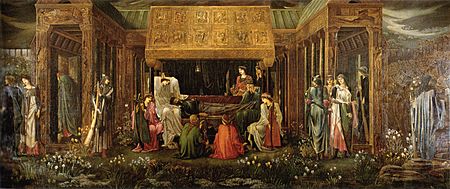
Aesthetic artists were proud of being separate from everyday life. They worked in their studios and rarely mixed with the public. Their paintings often showed human figures standing or sitting still, usually with calm faces.
Looking Back: The Classical Revival
As the century went on, life in Britain became more challenging. Many people started to look back at earlier times as a "golden age." Artists began to paint subjects and use techniques from before the Industrial Revolution. Art buyers especially liked paintings that connected the present to these idealized past times, like the Middle Ages. Stories about King Arthur were very popular.
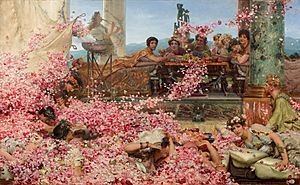
Because of this, paintings about medieval themes, especially Arthurian legends and religious stories, became very fashionable. Many famous artists from the aesthetic movement chose these themes. They did this even if they weren't religious, because it gave them a good reason to paint perfect figures and scenes. This helped them avoid showing the reality of industrial Britain. (Edward Burne-Jones, a major religious painter who wasn't Christian, once told Oscar Wilde, "The more materialistic science becomes, the more angels I shall paint.") Other painters focused on different periods of the past. Lawrence Alma-Tadema painted scenes from Ancient Rome. Former Pre-Raphaelite John Everett Millais started painting like artists from before the Industrial Revolution, such as Joshua Reynolds. Frederic Leighton specialized in idealized scenes from Ancient Greece.
Historical paintings had been popular before in Britain. But the trend in the late 1800s was different. In earlier times, the ancient world symbolized strength and power. But the aesthetic movement artists tried to copy the calmest works from the classical world, like the Venus de Milo. Painters from this period focused on calm scenes and inner feelings, not action. Also, unlike earlier revivals, they used bright colors instead of trying to show the plain look of classical stone.
Not all aesthetic artists agreed with looking back to an idealized past. Whistler, for example, strongly disliked this idea. He called it "this lifting of the brow in deprecation of the present—this pathos in reference to the past."
French Influence and Art Colonies
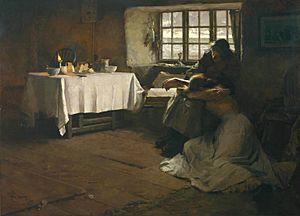
Even artists who didn't paint historical scenes were influenced by the move away from modern reality. In landscape painting, artists often stopped trying to paint realistic views. Instead, they focused on light effects and on showing parts of the countryside that they thought might soon disappear. Scenes of the countryside and country people (like farmers and fishermen) became very popular across Europe.
Art colonies started to appear in beautiful places. These allowed artists and students to work in the countryside and meet local people, while still being with other artists. The most famous of these was the Newlyn School in Cornwall. They were influenced by Jules Bastien-Lepage's style, where you can still see the brushstrokes. This suggested the simple life of the countryside. The techniques from the Newlyn School and other French impressionist styles (like those of Edgar Degas) were adopted by artists elsewhere. For example, John William Waterhouse combined these backgrounds with Pre-Raphaelite historical and classical images.
Older British painters were very doubtful about these French techniques. British artists had always been proud of having their own unique styles. They felt French-influenced painters looked too similar. John Everett Millais said they were "content to lose their identity in their imitation of their French masters." George Frederic Watts thought the rise of French styles showed a growing laziness in Britain. William Holman Hunt was worried that the paintings didn't have important subjects. Despite some changes at the Royal Academy, these new painters were often not allowed in the Summer Exhibition. So, in 1886, the New English Art Club was founded in London to show French-influenced art. This club later split into two groups: those who painted rural life and those who were more influenced by impressionism and new techniques.
What Happened Next: The Legacy of Victorian Art
The opening of the Tate Gallery in 1897 was a final triumph for Victorian painting. It was built to show sugar merchant Sir Henry Tate's collection of Victorian art. Many important Victorian artists died around this time.
In the 1910s, Victorian art and literature quickly went out of style in Britain. By 1915, the word "Victorian" was often used to mean something old-fashioned or bad. Many people blamed the First World War on the Victorian era. So, art from that time became very unpopular. Books that made fun of the Victorian age became popular. The new modernism art movement, which became big in the 20th century, looked to European art for ideas. They didn't care much for 19th-century British painting.
Throughout the 20th century, French impressionist and post-impressionist art became very valuable. Because Victorian painters had often criticized these French styles, many modern artists and critics in the early 1900s dismissed Victorian art.
In the 1940s, a book called The Pre-Raphaelite Tragedy by William Gaunt helped bring back some interest in Victorian art. British museums held events in 1948 to celebrate 100 years of the Pre-Raphaelite Brotherhood. But some art critics still made fun of them.
A big art show in 1951–52 at the Royal Academy of Arts showed many 19th-century British works. But overall, Victorian art was still not highly regarded.
In the 1960s, some parts of Victorian art became popular with the 1960s counterculture. Pre-Raphaelite art, in particular, was seen as an early version of Pop art. Several art shows about Pre-Raphaelite artists in the 1960s and 1970s helped their reputation. A major exhibition in 1984 at the Tate Gallery (now Tate Britain) about the whole Pre-Raphaelite movement was one of the most successful shows in the gallery's history.
Other Victorian art, not by the Pre-Raphaelites, mostly stayed out of fashion. In 1963, Flaming June, a famous painting by Sir Frederic Leighton, was valued at only £50. As late as 1967, art historian Quentin Bell wrote that Victorian art was "not important" from an art history point of view.
Even though non-Pre-Raphaelite Victorian art has gained a little more interest recently, it is still not as popular. Also, there aren't many big collections of it in the United States, which limits how well-known it is around the world.



